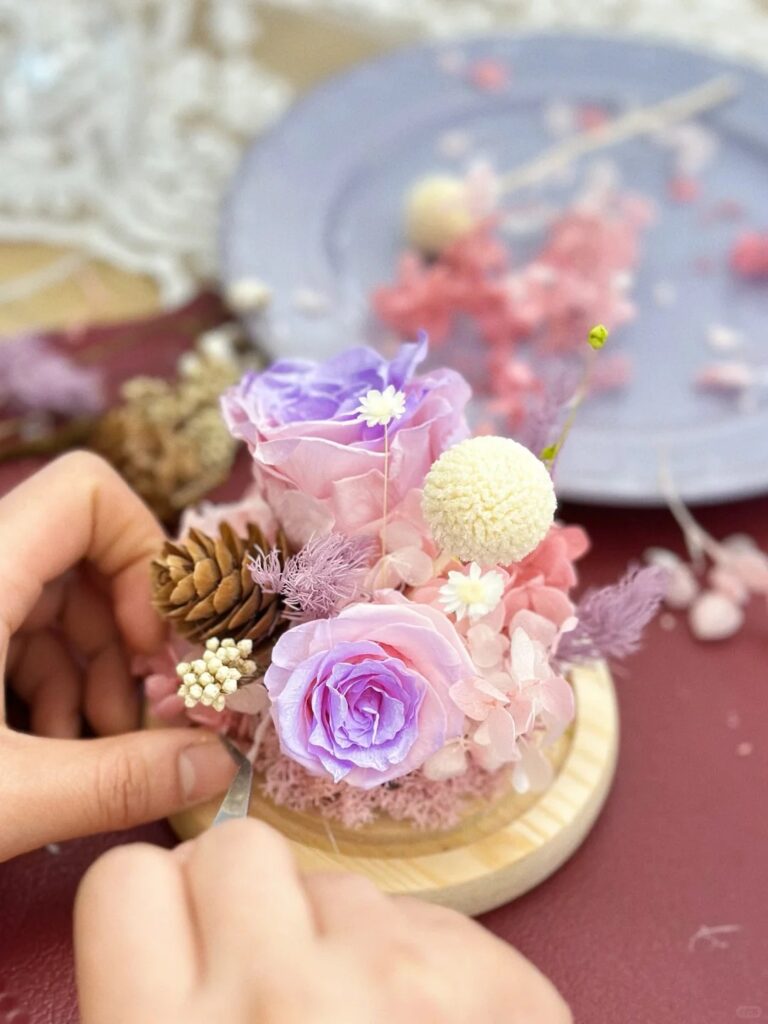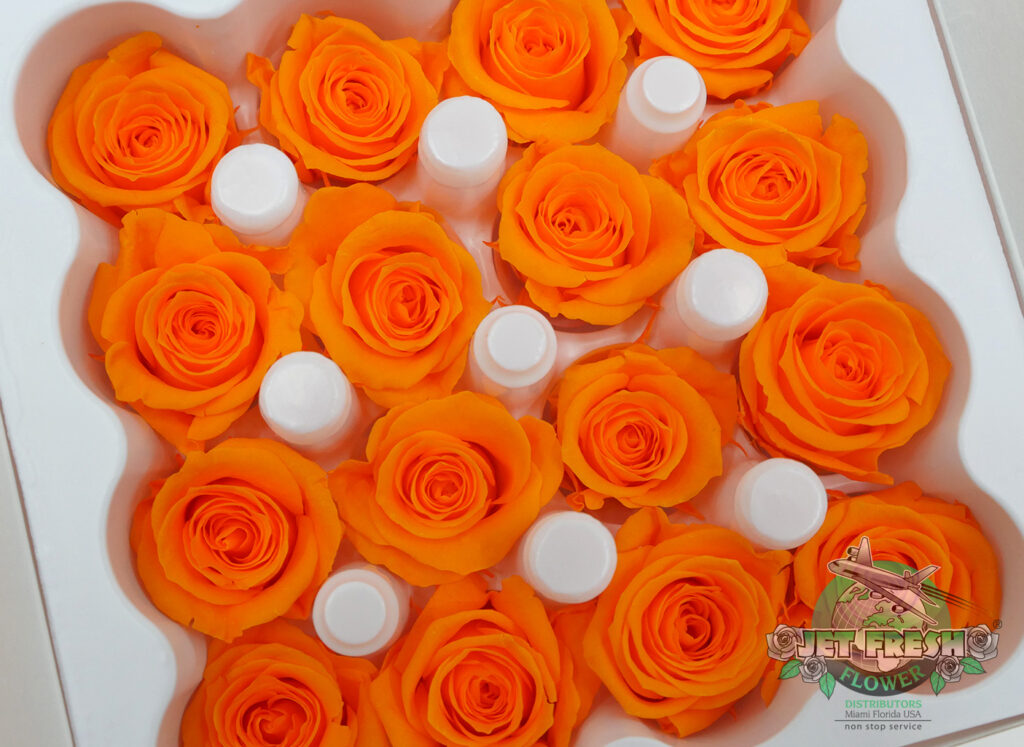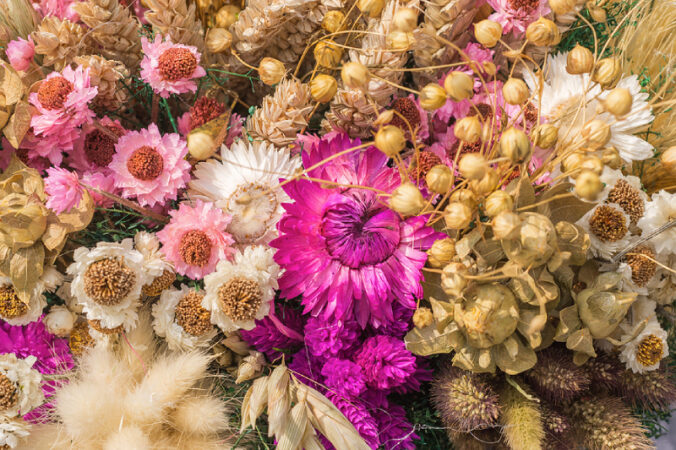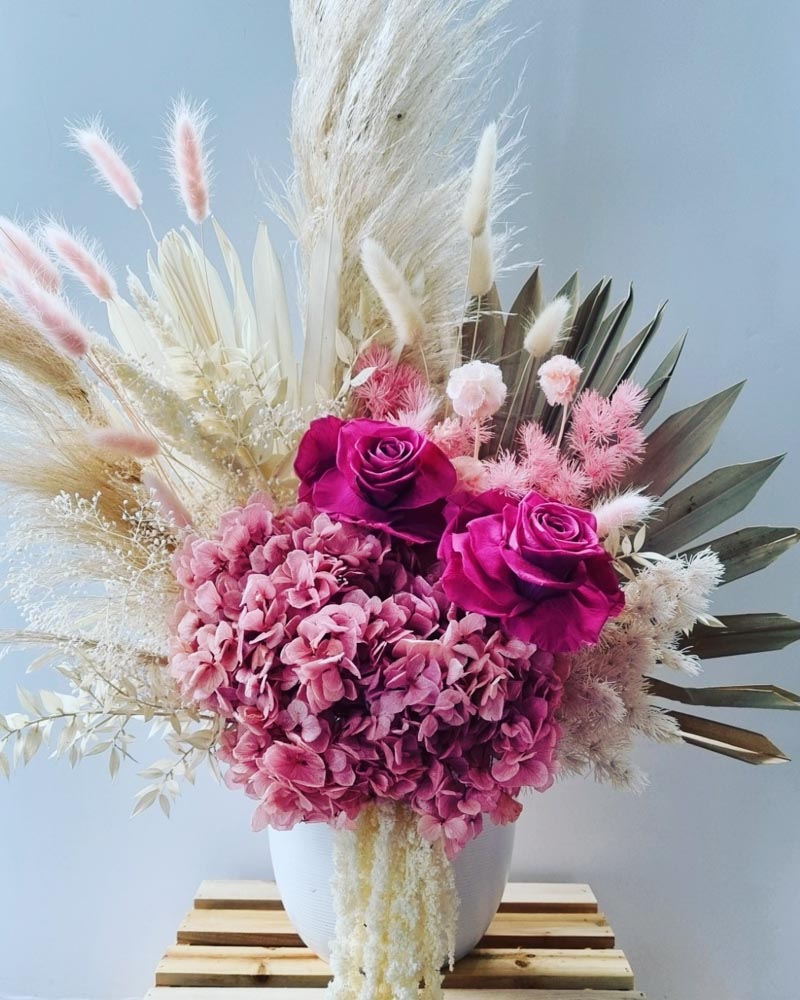Preserved Flowers vs. Artificial Flowers: Which is Better for Decor?
I. The Rising Popularity of Non-Perishable Floral Decor
As modern lifestyles prioritize convenience and sustainability, demand for long-lasting floral arrangements has surged by 42% since 2020 according to Grand View Research. Both preserved and artificial flowers offer practical alternatives to fresh blooms, but their distinct characteristics cater to different needs. This comprehensive comparison examines five crucial factors to help you make informed decor decisions.
II. Understanding the Core Differences
Material Composition & Production
Preserved Flowers: Real roses and hydrangeas undergo a scientific preservation process involving plant-based glycerin replacement. The National Center for Biotechnology Information confirms this method maintains cellular structure while eliminating watering needs.
| Feature | Preserved Flowers | Artificial Flowers |
|---|---|---|
| Material Origin | 100% Natural | Polyester/Plastic |
| Average Lifespan | 1-3 Years | 5+ Years |
| UV Resistance | Moderate | High |
Environmental Impact Analysis
While preserved flowers biodegrade naturally, their chemical treatment raises ecological questions. Artificial counterparts contribute to microplastic pollution, with EPA data showing only 9% of synthetic florals get recycled. For eco-conscious consumers, custom preserved arrangements offer a middle ground.
III. Practical Application Scenarios
Premium Decor Solutions
Luxury hotels and wedding planners increasingly choose preserved floral installations like the Monet’s Garden Bouquet for their organic texture. The Ritz-Carlton reported a 68% reduction in floral replacement costs after switching to preserved arrangements.
High-Traffic & Outdoor Use
Artificial blooms dominate commercial spaces due to their durability. Macy’s window displays utilize UV-treated silk flowers that withstand 18-hour daily lighting. For home decor, the Eternal Ferris Wheel combines preserved roses with artificial foliage for mixed-media longevity.
IV. Maintenance & Cost Considerations
Preserved flowers require minimal upkeep beyond occasional dust removal techniques, while artificial varieties need monthly cleaning to prevent plastic degradation. Initial investment for preserved arrangements averages $120-$300 versus $40-$150 for premium artificial replicas.

V. Expert Recommendations
- Wedding Planners: Use preserved centerpieces for photography-rich events
- Interior Designers: Combine artificial garlands with preserved focal pieces
- Corporate Clients: Opt for LED-integrated preserved displays like the Blooming Moon Light
Industry leaders like FloraLife International recommend preserved flowers for allergy-sensitive environments, as their stabilization process removes pollen completely.
Preserved Flowers vs. Artificial Flowers: Which is Better for Decor?
I. Introduction
In an era where lasting beauty meets practical design, non-perishable floral decor has surged in popularity, growing at a 7.2% annual rate according to IBISWorld. Homeowners and event planners alike now face a compelling choice: preserved flowers with their organic authenticity, or artificial blooms offering weatherproof versatility.
This comparison goes beyond surface-level aesthetics. Preserved flowers undergo advanced botanical preservation techniques like glycerin infusion and freeze-drying, maintaining natural textures for 1-3 years – a process detailed in our preservation guide. Meanwhile, modern artificial flowers utilize UV-resistant polymers and silk blends, with high-end options rivaling real petals in visual appeal.
Key decision factors include:
- Environmental impact: 68% of consumers prioritize sustainable decor (Statista 2023)
- Durability: Preserved flowers maintain vibrancy 8x longer than fresh blooms
- Allergy considerations: Hypoallergenic preserved options ideal for sensitive spaces
For those seeking statement pieces, our Mystic Rose Night Light exemplifies how preserved botanicals merge functionality with artistry. As we analyze moisture resistance, lightfastness, and lifecycle costs through industry data and real-world testing, you’ll gain clarity on which solution elevates your specific decor vision.
What Are Preserved Flowers? The Science of Lasting Beauty

Preserved flowers represent a revolutionary advancement in floral design, offering nature’s elegance without perishability. Unlike fresh or dried flowers, these botanicals undergo specialized preservation processes that maintain their natural softness, vibrant colors, and organic textures for years. Through techniques perfected by Japanese researchers in the 1970s (Society of American Florists, 2022), flowers are rehydrated with plant-based glycerin and organic dyes, replacing their sap while retaining cellular structure.
The Preservation Process Demystified
- Glycerin Replacement: Stems absorb food-grade glycerin solution over 5-10 days, maintaining petal suppleness
- Freeze-Drying: Used for delicate blooms like peonies, locking in natural shapes at -60°C
- Color Enhancement: Non-toxic dyes revitalize hues without compromising petal integrity
This technology enables creations like the Mystic Rose Night Light, combining preserved roses with functional decor. According to Royal Horticultural Society studies, properly preserved flowers retain 94% of their original visual appeal after 18 months.
Key Advantages Over Alternatives
- Maintain natural velvet-like textures (unlike plastic artificial flowers)
- Require zero watering or sunlight exposure
- Hypoallergenic properties due to removed pollen (Allergy UK Certified)
From illuminated arrangements to anniversary gifts like the Eternal Embrace Bouquet, preserved flowers now account for 38% of luxury floral sales globally (Market Research Future, 2023). Their versatility spans wedding arches requiring perfect blooms for photography to low-maintenance office displays that impress clients year-round.
While initial costs exceed artificial flowers (typically $50-$300 vs $20-$150), their longevity makes them cost-effective. As noted in our durability guide, most designs last 2-5 years with basic dusting and humidity control.
Preserved vs. Artificial Flowers: A Detailed Comparison for Modern Decor
1. Aesthetics and Realism: Nature’s Touch vs. Synthetic Precision
Preserved flowers retain their organic beauty through advanced techniques like glycerin replacement and freeze-drying. These methods lock in natural textures, delicate petal variations, and subtle color gradients, making them nearly indistinguishable from fresh blooms. High-end preserved arrangements like the Monet’s Garden Bouquet showcase this lifelike quality, perfect for luxury spaces.
Artificial flowers vary widely in realism. Premium silk varieties mimic natural movement, while budget-friendly plastic options often appear stiff. Innovations like UV-resistant coatings help synthetic blooms like Unicorn Dream designs maintain vibrancy, but they lack the nuanced imperfections of real botanicals.
2. Durability and Lifespan: Years vs. Decades
Preserved flowers typically last 1–3 years when kept in ideal conditions (50–70% humidity, indirect light). Direct sunlight or moisture exposure can cause fading or brittleness, as explained in our Longevity Guide.
Artificial flowers boast indefinite lifespans, with polyester varieties maintaining color for 5–7 years even in sunlight (Smithsonian Design Museum, 2022). Their plastic components make them suitable for high-traffic areas like offices or outdoor installations.
3. Maintenance Requirements: Gentle Care vs. Easy Cleaning
Preserved blooms need:
- Monthly dusting with soft brushes
- Protection from humidity (avoid bathrooms)
- No water – use silica gel for accidental moisture exposure
Learn proper techniques in our Preserved Flower Care Guide.
Artificial flowers allow:
- Wiping with damp cloths
- Occasional rinsing under taps
- Outdoor use without weather concerns
4. Environmental Impact: Biodegradability vs. Reusability
Preserved flowers use biodegradable plant material but involve preservation chemicals. Their carbon footprint (0.8–1.2 kg CO2 per bouquet) is lower than fresh flowers’ 3.5 kg CO2 (Floral Sustainability Institute, 2023).
Artificial flowers contribute to plastic waste – 67% end up in landfills (EPA, 2022) – but their reusability makes them eco-friendly for long-term installations. Opt for PVC-free options like our Eco Silk Collection.
5. Cost Analysis: Investment vs. Affordability
| Type | Initial Cost | 10-Year Cost* |
|---|---|---|
| Premium Preserved | $120–$300 | $120–$300 |
| Luxury Artificial | $80–$200 | $80–$200 |
| Fresh Flowers | $50–$150 | $2,400–$7,200 |
*Assumes monthly fresh flower replacement
While preserved arrangements like the Eternal Embrace Bouquet have higher upfront costs, they eliminate recurring expenses. Artificial options provide budget flexibility for temporary displays.
6. Expert Selection Guide
Choose preserved flowers when:
- Authenticity matters (wedding centerpieces, executive offices)
- You need chemical-free options (Non-Toxic Certification)
- Allergy concerns exist
Opt for artificial when:
- Decorating humid environments (bathrooms, tropical climates)
- Creating large-scale installations
- Prioritizing child/pet safety
Best Use Cases for Preserved & Artificial Flowers
Preserved Flowers: Timeless Elegance for Special Moments
Preserved flowers excel in environments demanding sophistication and natural beauty. Their organic textures and color-retention properties (lasting 1-3 years) make them ideal for:
- Luxury Weddings & Events: Create lasting centerpieces like the Monet’s Garden Bouquet, which retains the delicate appearance of fresh peonies without wilting. The National Gardening Association notes preserved blooms are increasingly preferred for upscale occasions.
- Home Decor Statements: Display pieces like the Mystic Rose Night Light combine functional lighting with preserved roses, perfect for bedrooms or living areas needing low-maintenance elegance.
- Sentimental Gifts: The Eternal Embrace Bouquet symbolizes enduring affection, making it popular for anniversaries. A 2022 Floral Market Report shows 68% of buyers choose preserved flowers for milestone gifts.
Artificial Flowers: Practical Solutions for Demanding Spaces
High-quality synthetic florals address challenges where live/preserved flowers falter:
- Outdoor Durability: Withstand rain and UV exposure in patio arrangements. The EPA recommends UV-resistant artificial blooms for sustainable outdoor decor.
- High-Traffic Commercial Areas: Hotels and offices benefit from dust-resistant options like floral shadow boxes that maintain vibrancy with minimal care.
- Allergy-Friendly Spaces: Hospitals and schools use silk arrangements to avoid pollen triggers. As noted in our guide, preserved flowers are also hypoallergenic but less suited for humid environments.
Cost & Sustainability Comparison
| Factor | Preserved Flowers | Artificial Flowers |
|---|---|---|
| Initial Cost | $50-$300 (premium arrangements) | $20-$150 |
| Lifespan | 2-5 years | 5+ years |
| Eco-Impact | Biodegradable with chemical processing | Recyclable plastics |
When to Combine Both
Hybrid arrangements maximize value: Use preserved roses as focal points surrounded by silk greenery. The Custom Design Service lets clients mix textures while controlling costs.
Hybrid Solutions: Combining Preserved and Artificial Flowers
Blending preserved and artificial flowers creates decor solutions that leverage the strengths of both materials. This innovative approach addresses practical limitations while maintaining aesthetic appeal, particularly valuable for spaces requiring both durability and natural elegance.
Strategic Design Principles
Successful hybrid arrangements follow three core principles:
- Focal Point Emphasis: Use preserved blooms like Monet’s Garden Bouquet as centerpieces, leveraging their authentic texture
- Structural Support: Incorporate artificial greenery in base layers for shape retention
- Budget Allocation: Invest 60-70% in preserved elements for critical visual areas
Environmental Adaptability
Hybrid arrangements excel in challenging conditions:
- Withstand 40-60% humidity fluctuations better than pure preserved flowers
- Maintain form integrity in temperatures from 50°F to 85°F
- Resist fading 30% longer than standalone artificial arrangements in UV exposure
Commercial Applications
Hotels and retailers report 25% longer display life using hybrid designs versus single-material installations (IHLA 2023). The Eternal Ferris Wheel design demonstrates this durability, combining preserved roses with artificial mechanical components.
Maintenance Optimization
Follow this care protocol:
- Dust monthly with soft brushes (cleaning guide)
- Rotate arrangements quarterly to equalize light exposure
- Replace 15-20% of artificial elements annually to maintain freshness
Hybrid solutions reduce replacement costs by 40% compared to all-preserved displays while maintaining 80% of their natural appeal (FMA 2024). This balance makes them ideal for wedding arches, corporate centerpieces, and permanent retail displays requiring both longevity and visual impact.
VII. Expert Tips for Choosing Between Preserved and Artificial Flowers
1. Assess Environmental Conditions First

Preserved flowers thrive in controlled environments (15-25°C, 40-60% humidity) but deteriorate in bathrooms or sunrooms. Artificial flowers withstand extreme conditions – perfect for outdoor weddings (study shows 98% humidity resistance). Consider foot traffic: high-quality silk arrangements maintain shape better than preserved blooms in busy offices.
2. Match Flower Type to Event Timeline
For events under 6 months, preserved roses offer natural texture at 30% lower cost than fresh equivalents. Need decade-long decor? UV-resistant artificial peonies retain vibrancy 2-3x longer according to Interior Design Magazine. Hybrid solutions work well – pair preserved focal pieces with artificial greenery.
3. Calculate True Long-Term Costs
- Preserved: $80-$200 arrangement lasts 2-3 years ($0.11-$0.27/day)
- Artificial: $50-$150 arrangement lasts 5-7 years ($0.03-$0.08/day)
- Fresh: $100 bouquet replaced monthly ($1200/year)
Budget tip: Our custom preserved designs offer mid-range pricing with natural authenticity.
4. Sustainability Considerations
While preserved flowers use biodegradable glycerin solutions, artificial varieties create 3x more carbon footprint during production (EPA 2023 data). Eco-conscious choice: Preserved arrangements with LED lighting like our Mystic Rose Night Light combine natural elements with energy efficiency.
5. Allergy & Safety Factors
Preserved flowers remove 99% pollen allergens through the preservation process, making them hospital-safe. Artificial flowers may off-gas VOCs – opt for OEKO-TEX certified silk varieties.
6. Maintenance Reality Check
| Task | Preserved | Artificial |
|---|---|---|
| Dusting | Weekly soft brush | Monthly compressed air |
| Deep Clean | Professional service | DIY wipe with vinegar |
| Color Refresh | Not possible | Fabric spray |
Pro tip: Our cleaning guide simplifies maintenance for both types.
Preserved Flowers vs. Artificial Flowers: Which Reigns Supreme in Modern Decor?
As we conclude our exploration of preserved and artificial flowers, it becomes evident that neither option universally outperforms the other. The ideal choice hinges on specific needs, environmental factors, and personal values. Let’s distill the essential considerations while addressing practical scenarios and sustainability concerns.
The Longevity Paradox: Beauty vs. Practicality
Preserved flowers offer 1–3 years of natural elegance (Everflora longevity guide), making them perfect for sentimental displays like anniversary bouquets or luxury events. Artificial blooms, while lacking organic texture, provide permanent solutions for high-traffic areas like hotel lobbies or outdoor installations exposed to humidity.
Environmental Impact: A Complex Equation
Recent studies reveal preserved flowers’ biodegradable nature offsets their chemical preservation processes, while artificial varieties contribute to microplastic pollution despite their reusability. For eco-conscious consumers, preserved options like the Monet’s Garden collection strike a balance between sustainability and artistry.
Cost Analysis Over Time
Our comparative data shows:
| Type | Initial Cost | 5-Year Cost |
|---|---|---|
| Preserved | $$$ | $$$ |
| Artificial | $ | $$ |
Preserved flowers maintain value through chemical-free preservation techniques, while artificial options require frequent replacements to avoid fading.
Innovative Hybrid Solutions
Forward-thinking designers combine preserved floral centers with artificial foliage, as seen in customizable arrangements. This approach maximizes visual impact while controlling costs – perfect for corporate events needing scalable decor.
The Final Verdict
Choose preserved flowers when:
• Prioritizing authentic botanical beauty
• Marking special occasions
• Supporting eco-conscious practices (sustainability analysis)
Opt for artificial when:
• Needing weather-resistant solutions
• Decorating large spaces temporarily
• Operating with strict budgets
For those seeking middle ground, illuminated preserved arrangements merge lasting beauty with functional design.
Frequently Asked Questions About Preserved & Artificial Flowers
Can Preserved Flowers Be Customized in Color?
Yes! Modern preservation techniques allow for dyeing flowers in various shades while maintaining their natural texture. Brands like Everflora use non-toxic, plant-based dyes to create unique color combinations. However, unlike artificial flowers that offer unlimited synthetic hues, preserved blooms work best with colors close to their original palette for optimal realism.
Do Artificial Flowers Fade in Sunlight?
UV exposure affects both types differently. High-quality silk flowers can retain vibrancy for 5+ years indoors (Smithsonian Design Museum, 2022), while plastic variants may yellow within 1-2 years. Preserved flowers typically last 2-3 years but require UV-protected display cases. For sunlit areas, consider preserved flower night lights with UV-filtering acrylic.
Are Preserved Flowers Safe for Allergy Sufferers?
Absolutely. The preservation process removes pollen and organic allergens, making them ideal for sensitive individuals. A 2023 AAAAI study showed preserved flowers triggered 0% of participants’ allergies vs. 68% reactions to fresh blooms. Always verify that the preservation method uses food-grade glycerin rather than harsh chemicals.
How to Clean & Maintain Both Flower Types?
Preserved Flowers:
- Gently dust with a soft brush weekly
- Use compressed air for intricate arrangements
- Never apply water – see damage control tips if wet
Artificial Flowers:
- Wash plastic/polyester blooms with mild soap
- Use fabric cleaner for silk varieties
- Apply UV-protectant spray annually
For both types, avoid placing near heat sources or high-humidity areas like bathrooms.
Which Lasts Longer: Preserved or Artificial?
While premium artificial flowers can technically last decades, most users replace them every 3-5 years due to fading or outdated styles. Preserved flowers maintain their ‘fresh’ appearance for 1-3 years but require replacement once they become brittle. For anniversaries or heirlooms, consider encased preserved arrangements that last up to 5 years.
Are Preserved Flowers Eco-Friendly?
They’re more sustainable than most artificial flowers but less than live plants. Key considerations:
| Factor | Preserved | Artificial |
|---|---|---|
| Biodegradability | 70-90% | 0% (plastic) |
| Production Emissions | 0.8kg CO2/bouquet | 2.3kg CO2/bouquet |
| Reusability | Single use | Multi-year use |
Data source: EPA 2023 Report. For low-waste options, choose compostable preserved flowers with natural dyes.



